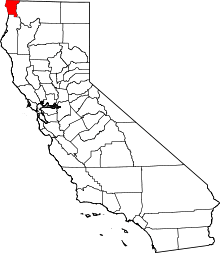Resighini Rancheria
The Resighini Rancheria, located just south of Klamath, California, is a rancheria and a federally recognized tribe.
The reservation (on land measuring 228 acres) is primarily settled by members affiliated with the rancheria. A resident population of 36 persons was reported during the 2000 census. The 2010 US Census shows a decrease, with a population of 31. It is entirely surrounded by the Yurok Indian Reservation.
In 1938, the US government purchased 228 acres from a man named Augustus Resighini. This land became a reservation in 1939. In 1975, members formed a tribal government that was approved by the Secretary of Interior.[1]
Tribal Government
The tribal government was formed in 1975 and is headquartered in Klamath, California. They are governed by a democratically elected, five-member Tribal Council. The general membership serves on boards, committees, commission and corporations to assist the Tribal Council.[2]
The current Tribal Administration is as follows:
- Chairperson: Fawn Che-gere Murphy
- Vice Chairperson: Moonchay Kari Dowd
- Secretary: Frank Spa-ghe Dowd
- Treasurer: Allen S. Davis
- Councilmember: Kathy Dowd
- Executive Director: Megan Van Pelt
In 2003, the Resighini Rancheria established a tribal court to oversee criminal offenses as well as regulatory procedures regarding fishing and wildlife.[3]
Cultural Life
Resighini Rancheria tribal members participate in traditional dances such as the Brush Dance, as well as the Jump Dance and White Deer Skin Dance.[4]
The Brush Dance is a ceremony held to heal a sick child or to pray for a long, healthy life for the child. Families come together around a dance pit, beginning on a Wednesday where the medicine doctor, the child and the child's family begin. Actual dancing begin on Thursday evening with two dances. Both females and males dance.[5]
The Jump Dance lasts for 10 days. The Jump Dance was revived in 1984. The dance is held to prevent sickness, to bring happiness, and to restore balance in the universe. The dancers wear elaborate outfits, including headdresses with 70 redheaded woodpecker scalps. In addition to the headdress, the dancers also wear dentalia shell necklaces and a deerskin skirt and they carry a Jump Dance basket in the right hand.[6]
The White Deerskin Dance is generally held around same time as the Jump Dance. Canoes are used to transport dances. It seems dancers carry poles with deer heads draped by deerskins. This dance provides protection to the people. This dance was also recently revived.[7]
Tribal members also engage in the traditions of storytelling, gathering seaweed, mussels and other marine resources for basket making, and subsistence fishing for salmon, trout and eel and other species.[8]
Fishing Controversy
The Resighini rancheria is completely enclosed within the Yurok reservation. As a result, fishing conflicts have arisen with the Yurok tribe. The Yurok tribe is the largest in California with 6311 members. The Yurok tribe claims jurisdiction over Resighini lands and interferes with tribal members’ ability to fish at the Klamath River. In May 2016, the Yurok tribe filed a federal lawsuit to stop members of the Resighini Rancheria from gillnet fishing off of the Klamath River. According to the Yurok tribe, in 1991, the Hoopa-Yurok Settlement Act divided lands into the Yurok and the Hoopa reservations. The Resighini Rancheria was offered the option of joining the Yurok tribe in order to have access to Yurok lands and access to fishing. Instead, the tribal members opted for a $15,000 per person payout. The Yurok argue that the Resighini gave up their fishing rights when they made this agreement.[9] The Resighini members argue that they retained their fishing rights and that the Yurok are unjustly interfering with their land and water use.[10] The Yurok further argue that they are in the midst of a massive conservation effort, and the Resighini are interfering in their attempts to save the fish in the Klamath River.[11]
Dam Controversy
The area surrounding the Resighini Rancheria has been impacted by government-built dams. The Secretary of Interior began a process to consider removal of Klamath Hydroelectric Power dams through the Klamath Settlement Agreement in 2010. However, the tribe opposes the settlement because it argues that the Agreement does not have any provisions for ecological restoration and delays dam removal until 2020.[12] The Agreement is set to expire soon because there is no authorizing legislation and the dam does not wish to extend the deadline. The tribe believes the US government must take steps to address water pollution and restore Native fishes, particularly suckers and salmon that are threatened with extinction. The Yurok tribe supports the Agreement.[13] To further complicate matters, anti-Indian groups, such as the Klamath Party Tea Party Patriots have intervened against the Agreement because they oppose the removal of dams because they think it will hurt the agricultural industry.[14]
References
- /Resighini Rancheria, Resighini Rancheria official website
- /Resighini Rancheria, Resighini Rancheria official website
- /Resighini Rancheria, Resighini Rancheria official website
- /Resighini Rancheria, Resighini Rancheria official website
- /Yurok Tribe official website
- Richard Keeling, Cry for Luck: Sacred Song and Speech Among the Yurok, Hupa, and Karok Indians of Northwestern California. Berkeley: University of California Press, 1993: 80-90.
- Richard Keeling, Cry for Luck: Sacred Song and Speech Among the Yurok, Hupa, and Karok Indians of Northwestern California. Berkeley: University of California Press, 1993: 80-90.
- / UC Santa Barbara Marine Life Protection Act Project website.
- /"Fish War" Lost Coast Outlook
- /Resighini Rancheria, Resighini Rancheria official website
- /"Fish War" Lost Coast Outlook
- /Klamath Dam Deal
- /Resighini Rancheria, Resighini Rancheria official website
- /Tea Parties, Property Rights and Anti-Indianism in the Klamath River Basin
